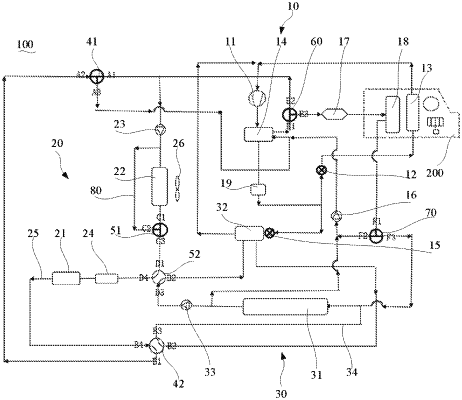| CPC B60H 1/00392 (2013.01) [B60H 1/00485 (2013.01); B60H 1/00899 (2013.01); B60H 1/143 (2013.01); B60H 1/3228 (2019.05); B60K 2001/005 (2013.01)] | 20 Claims |

|
1. A thermal management system, applied to an electric vehicle, wherein the electric vehicle comprises a passenger compartment, and the thermal management system comprises:
a passenger compartment thermal management subsystem, comprising:
a compressor comprising an outlet and a return inlet, a first throttle, an evaporator, a second throttle, a cooler, and a condenser,
wherein the compressor, the first throttle, and the evaporator are controlled to communicate with each other in sequence to form a first refrigerant circuit configured to refrigerate the passenger compartment;
wherein the compressor and the second throttle are controlled to communicate with each other to form a second refrigerant circuit;
wherein the condenser is disposed between the compressor and the first throttle and disposed between the compressor and the second throttle, and the condenser is able to exchange heat with the first refrigerant circuit and the second refrigerant circuit;
wherein the cooler is disposed between the return inlet and the second throttle and able to exchange heat with the second refrigerant circuit;
a heat emitting component thermal management subsystem, comprising a motor thermal management subsystem, a power battery thermal management subsystem, and a cooling water tank, the motor thermal management subsystem comprising a motor, and the power battery thermal management subsystem comprises a power battery; and
a control valve system, connected to the passenger compartment thermal management subsystem and the heat emitting component thermal management subsystem, wherein the control valve system is able to control the cooling water tank and the condenser to communicate with each other to form a first cooling water circuit and control the two ends of the cooler to communicate with each other to form a second cooling water circuit, the first cooling water circuit is configured to cool the motor, and the second cooling water circuit is configured to cool the power battery.
|